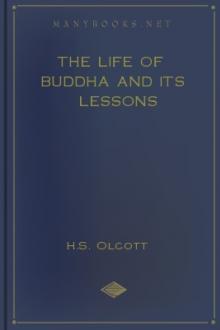Man, Past and Present, Agustus Henry Keane, A. Hingston Quiggin, Alfred Court Haddon [series like harry potter txt] 📗

Book online «Man, Past and Present, Agustus Henry Keane, A. Hingston Quiggin, Alfred Court Haddon [series like harry potter txt] 📗». Author Agustus Henry Keane, A. Hingston Quiggin, Alfred Court Haddon
In the interior, between the southern coast ranges and the Zambesi, the Hottentot and Bushman aborigines were in prehistoric ages almost everywhere displaced or reduced to servitude by other Bantu peoples such as the Ma-Kalakas and Ma-Shonas, the Be-Chuanas and the kindred Ba-Sutos. Of these the first arrivals (from the north) appear to have been the Ma-Shonas and Ma-Kalakas, who were being slowly "eaten up" by the Ma-Tabili when the process was arrested by the timely intervention of the English in Rhodesia.
Both nations are industrious tillers of the soil, skilled in metal-work and in mining operations, being probably the direct descendants of the natives, whose great chief Monomotapa, i.e. "Lord of the Mines," as I interpret the word[258], ruled over the Manica and surrounding auriferous districts when the Portuguese first reached Sofala early in the sixteenth century. Apparently for political reasons[259] this Monomotapa was later transformed by them from a monarch to a monarchy, the vast empire of Monomotapaland, which was supposed to comprise pretty well everything south of the Zambesi, but, having no existence, has for the last two hundred years eluded the diligent search of historical geographers.
But some centuries before the arrival of the Portuguese the Ma-Kalakas with the kindred Ba-Nyai, Ba-Senga and others, may well have been at work in the mines of this auriferous region, in the service of the builders of the Zimbabwe ruins explored and described by the late Theodore Bent[260], and by him and many others attributed to some ancient cultured people of South Arabia. This theory of prehistoric Oriental origin was supported by a calculation of the orientation of the Zimbabwe "temple," by reports of inscriptions and emblems suggesting "Phoenician rites," and by the discovery, during excavation, of foreign objects. Later investigation, however, showed that the orientation was based on inexact measurements; no authentic inscriptions were found either at Zimbabwe or elsewhere in connection with the ruins; none of the objects discovered in the course of the excavations could be recognised as more than a few centuries old, while those that were not demonstrably foreign imports were of African type. In 1905 a scientific exploration of the ruins placed these facts beyond dispute. The medieval objects were found in such positions as to be necessarily contemporaneous with the foundation of the buildings, all of which could be attributed to the same period. Finally it was established that the plan and construction of Zimbabwe instead of being unique, as was formerly supposed, only differed from other Rhodesian ruins in dimensions and extent. The explorers felt confident that the buildings were not earlier than the fourteenth or fifteenth century A.D., and that the builders were the Bantu people, remains of whose stone-faced kraals are found at so many places between the Limpopo and the Zambesi. Their conclusions, however, have not met with universal acceptance[261].
With the Be-Chuanas, whose territory extends from the Orange river to Lake Ngami and includes Basutoland with a great part of the Transvaal, we again meet a people at the totemic stage of culture. Here the eponymous heroes of the Zulu-Xosas are replaced by baboons, fishes, elephants, and other animals from which the various tribal groups claim descent. The animal in question is called the siboko of the tribe and is held in especial reverence, members (as a rule) refraining from killing or eating it. Many tribes take their name from their siboko, thus the Ba-Tlapin, "they of the fish," Ba-Kuena, "they of the crocodile." The siboko of the Ba-Rolong, who as a tribe are accomplished smiths, is not an animal, but the metal iron[262].
With a section of the great Be-Chuana family, the Ba-Suto, and the Ba-Rotse is connected one of the most remarkable episodes in the turbulent history of the South African peoples during the nineteenth century. Many years ago an offshoot of the Ba-Rotse migrated to the Middle Zambesi above the Victoria Falls, where they founded a powerful state, the "Barotse (Marotse) Empire," which despite a temporary eclipse still exists as a British protectorate. The eclipse was caused by another migration northwards of a great body of Ma-Kololo, a branch of the Ba-Suto, who under the renowned chief Sebituane reached the Zambesi about 1835 and overthrew the Barotse dynasty, reducing the natives to a state of servitude.
But after the death of Sebituane's successor, Livingstone's Sekeletu, the Ba-Rotse, taking advantage of their oppressors' dynastic rivalries, suddenly revolted, and after exterminating the Ma-Kololo almost to the last man, reconstituted the empire on a stronger footing than ever. It now comprises an area of some 250,000 square miles between the Chobe and the Kafukwe affluents[263], with a population vaguely estimated at over 1,000,000, including the savage Ba-Shukulumbwe tribes of the Kafukwe basin reduced in 1891[264].
Yet, short as was the Ma-Kololo rule (1835-70), it was long enough to impose their language on the vanquished Ba-Rotse[265]. Hence the curious phenomenon now witnessed about the Middle Zambesi, where the Ma-Kololo have disappeared, while their Sesuto speech remains the common medium of intercourse throughout the Barotse empire. How often have analogous shiftings and dislocations taken place in the course of ages in other parts of the world! And in the light of such lessons how cautious ethnographists should be in arguing from speech to race, and drawing conclusions from these or similar surface relations!
Referring to these stirring events, Mackenzie writes: "Thus perished the Makololo from among the number of South African tribes. No one can put his finger on the map of Africa and say, 'Here dwell the Makololo[266].'" This will puzzle many who since the middle of the nineteenth century have repeatedly heard of, and even been in unpleasantly close contact with, Ma-Kololo so called, not indeed in Barotseland, but lower down the Zambesi about its Shire affluent.
The explanation of the seeming contradiction is given by another incident, which is also not without ethnical significance. From Livingstone's Journals we learn that in 1859 he was accompanied to the east coast by a small party of Ma-Kololo and others, sent by his friend Sekeletu in quest of a cure for leprosy, from which the emperor was suffering. These Ma-Kololo, hearing of the Ba-Rotse revolt, wisely stopped on their return journey at the Shire confluence, and through the prestige of their name have here succeeded in founding several so-called "Makololo States," which still exist, and have from time to time given considerable trouble to the administrators of British Central Africa. But how true are Mackenzie's words, if the political be separated from the ethnical relations, may be judged from the fact that of the original founders of these petty Shire states only two were full-blood Ma-Kololo. All the others were, I believe, Ba-Rotse, Ba-Toka, or Ba-Tonga, these akin to the savage Ba-Shukulumbwe.
Thus the Ma-Kololo live on, in their speech above the Victoria Falls, in their name below the Victoria Falls, and it is only from history we know that since about 1870 the whole nation has been completely wiped out everywhere in the Zambesi valley. But even amongst cultured peoples history goes back a very little way, 10,000 years at most anywhere. What changes and shiftings may, therefore, have elsewhere also taken place during prehistoric ages, all knowledge of which is now past recovery[267]!
Few Bantu peoples have lent a readier ear to the teachings of Christian propagandists than the Xosa, Ba-Suto, and Be-Chuana natives. Several stations in the heart of Kafirland--Blythswood, Somerville, Lovedale, and others--have for some time been self-supporting, and prejudice alone would deny that they have worked for good amongst the surrounding Gaika, Galeka, and Fingo tribes. Sogo, a member of the Blythswood community, has produced a translation of the Pilgrim's Progress, described by J. Macdonald as "a marvel of accuracy and lucidity of expression[268]"; numerous village schools are eagerly attended, and much land has been brought under intelligent cultivation.
The French and Swiss Protestant teachers have also achieved great things in Basutoland, where they were welcomed by Moshesh, the founder of the present Basuto nation. The tribal system has yielded to a higher social organisation, and the Ba-Tau, Ba-Puti, and several other tribal groups have been merged in industrious pastoral and agricultural communities professing a somewhat strict form of Protestant Christianity, and entirely forgetful of the former heathen practices associated with witchcraft and ancestry-worship. Moshesh was one of the rare instances among the Kafirs of a leader endowed with intellectual gifts which placed him on a level with Europeans. He governed his people wisely and well for nearly fifty years, and his life-work has left a permanent mark on South African history[269].
In Bechuanaland one great personality dominates the social horizon. Khama, king of the Ba-Mangwato nation, next to the Ba-Rotse the most powerful section of the Be-Chuana, may be described as a true father of his people, a Christian legislator in the better sense of the term, and an enlightened reformer even from the secular point of view.
When these triumphs, analogous to those witnessed amongst the Lacustrians and in other parts of Bantuland, are contrasted with the dull weight of resistance everywhere opposed by the full-blood Negro populations to any progress beyond their present low level of culture, we are the better able to recognise the marked intellectual superiority of the negroid Bantu over the pure black element.
West of Bechuanaland the continuity of the Bantu domain is arrested in the south by the Hottentots, who still hold their ground in Namaqualand, and farther north by the few wandering Bushman groups of the Kalahari desert. Even in Damaraland, which is mainly Bantu territory, there are interminglings of long standing that have given rise to much ethnical confusion. The Ova-Herero, who were here dominant, and the kindred Ova-Mpo of Ovampoland bordering on the Portuguese possessions, are undoubted Bantus of somewhat fine physique, though intellectually not specially distinguished. Owing to the character of the country, a somewhat arid, level steppe between the hills and the coast, they are often collectively called "Cattle Damaras," or "Damaras of the Plains," in contradistinction to the "Hill Damaras" of the coast ranges. To this popular nomenclature is due the prevalent confusion regarding these aborigines. The term "Damara" is of Hottentot origin, and is not recognised by the local tribes, who all call themselves Ova-Herero, that is, "Merry People." But there is a marked difference between the lowlanders and the highlanders, the latter, that is, the "Hill Damaras," having a strong strain of Hottentot blood, and being now of Hottentot speech.
The whole region is a land of transition between the two races, where the struggle for supremacy was scarcely arrested by the temporary intervention of German administrators. Though annexed by Germany in 1884, fighting continued for ten years longer, and, breaking out again in 1903, was not subdued until 1908, after the loss to Germany of 5000 lives and L15,000,000, while 20,000 to 30,000 of the Herero are estimated to have perished. Under the rule of the Union of South Africa this





Comments (0)